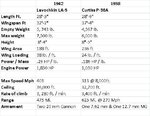GrauGeist
Generalfeldmarschall zur Luftschiff Abteilung
The SCR-720A radar system used in the P-61 was not only heavy as mentioned, but was also large in size. You would have to modify the fuselage quite a bit in order to fit that antenna assembly in the nose.
After all the modifications and refitting, you'd probably end up with something that looked alot like the XP-58
After all the modifications and refitting, you'd probably end up with something that looked alot like the XP-58




